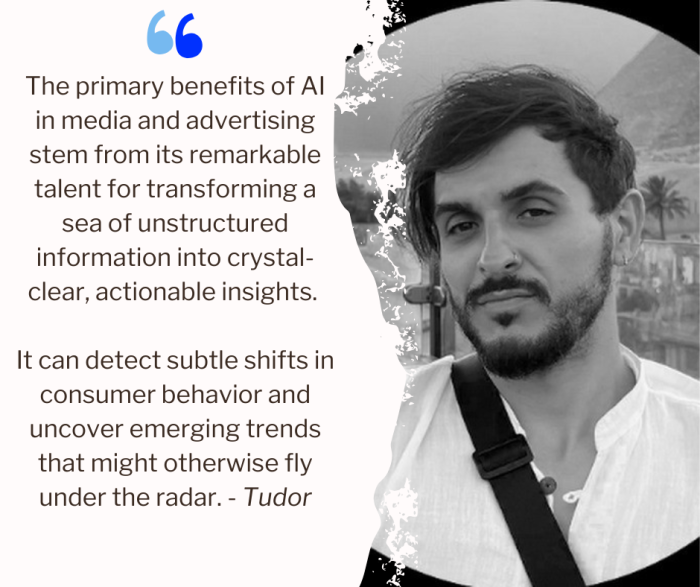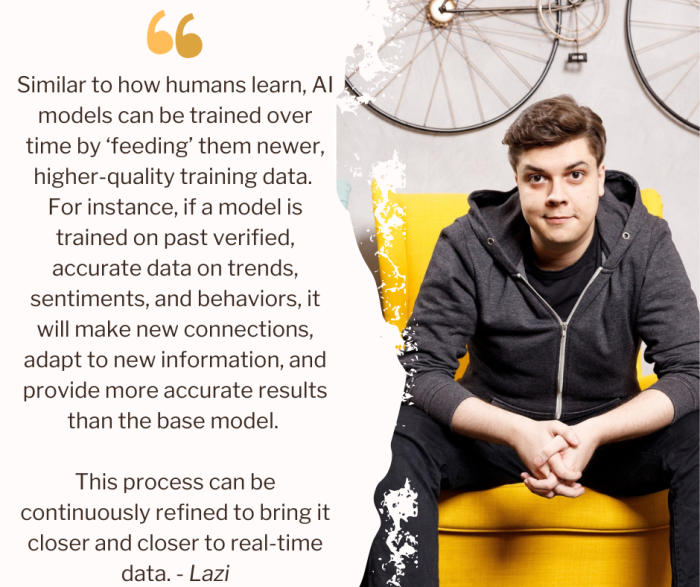The artificial intelligence (AI) is a powerful tool, but its real impact depends on the people who use it. The ability to transform raw data into relevant, actionable solutions isn’t just about algorithms – it’s about human expertise, creativity, and strategic thinking.
We asked our colleagues, Tudor Chiriță – Senior Data Scientist and Valentin Lăzureanu (Lazi) – AI Specialist how the artificial intelligence is transforming media and advertising. Hear directly from those shaping the future of our industry.
How can AI provide actionable insights for media & advertising?
Tudor – In my experience, AI’s true strength lies in turning vast mountains of data into clear, actionable insights. By crunching numbers, spotting patterns, and forecasting trends, it shows us exactly what’s working and what isn’t. Imagine having an incredibly efficient brain that processes data at a scale we could only dream of, tirelessly working around the clock without ever needing a break. This remarkable capability not only enhances our analytical efforts but also empowers us to make smarter, faster decisions every day.
Lazi – I think the real strength lies in the amount of data we can now process incredibly fast and relatively easy for cheap(er). It’s an ongoing race on who can put together better datasets, on scales we haven’t seen implemented yet. More data means, of course, better forecasts and a plethora of new insights we might have missed out on solely because of the amount of information we had available and couldn’t process on time. It’s a huge step for productivity and, paired with human intelligence and creativity, can bring huge shifts on how we create, interact and analyze content.
What are the primary benefits and challenges of using AI in media & advertising?
On the flip side, these benefits come with their own set of challenges. In our sustainable living scenario, it’s essential to ensure that the insights are derived from high-quality, unbiased data; otherwise, we risk chasing a false trend. Additionally, we must address privacy concerns and be mindful of how data is used, all while striking the delicate balance between AI’s analytical power and the creative, human touch that truly resonates with audiences.
Lazi – We can see benefits all across the board but especially on enhancing productivity. Apart from crunching data, we can now output faster creative proposals with Generative AI images, videos and audio. We can have readily available knowledge bases and chatbots to act as role-assistants and we’ll very soon see an even further leap to this, via newer Agentic AI models.
Challenges, on the other hand, are just as big as the benefits. We have to take into consideration the ethical and legal concerns of using AI as well as the evident work-displacement aspects of it. The goal is not to replace human creativity – which in my opinion is irreplaceable – but rather enhance it and offer it the needed tools and assistance.
What emerging technologies or innovations might shape the future of AI in media & advertising?
Tudor – Emerging technologies poised to shape the future of AI in media and advertising include advanced generative models, refined natural language processing, and real-time analytics. For instance, our platform SnappyAI leverages these innovations to analyze sentiment, identify themes relevant to our brand, and use our brand archetype to generate compelling content. This approach enables us to create personalized campaigns that dynamically adapt to audience behaviour.
Lazi – The next two big leaps I’m personally looking for are newer and true Agentic AI models and new findings on how efficiently we can run said models locally, on-device. First one (the Agentic AI) – I think will cause a big shift on how we do certain time-intensive tasks (eg. research/web scraping) while the other, running said models locally without a huge infrastructure upgrade, will give us full control on our data, without sending anything to a third party and while cutting costs (such as API costs) dramatically. Innovations in this sectors are coming out fast, we can see improvements in different directions on a weekly basis almost.
How can businesses effectively adopt these trends while balancing automation with the human touch?
Tudor – Businesses should use AI as an extension of their team not a replacement. Leverage AI to streamline data analysis and automate routine tasks, but always ensure that final decisions, creative direction, and strategy receive that indispensable human touch.
Lazi – Humans touch should always be the deciding factor. To effectively adopt these trends, we must use automation as a helper, a tool, not as a cheap replacement to human reasoning and creativity. That’s a false lead and while yes, some tasks can be fully automated, that doesn’t mean no human oversight should be present in that process. Large Language Models, in this state, still hallucinate for example, even if increasingly fewer times. Apart from this, some human creative ideas simply can’t be replicated by “statistical thinking”. We must be mindful of the trap that is a “perfect” statistical response – which can sometimes, in emotion-packed times, be in conflict with how humans actually act.
How does AI adapt to evolving language patterns, slang, or regional dialects in social listening?
Lazi – This mostly depends on the ability of said model to be up to date with the actual training data. I don’t think this will be a problem in the very near future, with most models trying their best to integrate new data into their datasets as fast as possible – in some cases even in real time. If there’s data on it, the model will have no problem adapting to it.
Tudor – When it comes to tracking how language evolves, modern AI really steps up. It uses advanced natural language processing and continuous learning to catch new slang, regional dialects, and shifting language patterns. The key is having a robust, diverse dataset and a rigorous training process. By constantly updating these datasets with real-time info, AI can adapt quickly to new linguistic trends, ensuring that social listening stays both accurate and contextually relevant.
How does AI improve accuracy over time in identifying trends, sentiment, and consumer behaviors?
Tudor – Imagine honing a skill over time each new experience makes you sharper. AI works in a similar way. With every new data point and piece of feedback, it fine-tunes its algorithms to better recognize trends, gauge sentiment, and understand consumer behaviors. This is called the Iterative Learning Process, which simply means the system continuously learns from each cycle of data, refining its predictions and improving its accuracy over time.
For example, picture a popular bakery in Cluj launching a new cozonac flavor (cozonac cu aromă de șorici). Social media soon erupts with playful memes and witty comments about it. Over time, our AI picks up on these bursts of local enthusiasm, learning that such lively chatter signals genuine consumer excitement. This not only makes the AI smarter but also helps us quickly spot and act on emerging trends with a local flavor.
Of course, in this case, cozonac cu aromă de șorici is a fictional example, but AI needs to learn how to distinguish between genuine hype and viral jokes.
How does AI distinguish between meaningful insights and irrelevant noise?
Lazi – Simply put – statistics. It distinguishes between meaningful insights and irrelevant noise by both filtering data and pattern seeking. Being trained on such vast amounts of data, it can identify different patterns in data by comparing the presented data with already trained-in data from the past. I think it’s also dependent on how said AI models are configured and chosen – what prompts and instructions are used and most importantly, what capabilities that model has (eg. the new models with reasoning, applying Chain-Of-Thoughts Prompting to improve the outputs).
Tudor – AI distinguishes meaningful insights from noise by applying advanced filtering and pattern recognition techniques. It systematically compares new data against historical trends and statistical benchmarks to identify patterns that regularly occur, rather than reacting to isolated, random spikes.
How can businesses address ethical concerns, such as privacy and bias, in AI-driven media & advertising?
Tudor – Businesses can address ethical concerns by embedding transparency and accountability into their AI strategies. This means establishing robust data privacy policies, regularly auditing algorithms to identify and eliminate bias, and involving diverse perspectives in AI development. In short, ethics should be a core value, not an afterthought, ensuring that AI-driven media and advertising remain both innovative and responsible.
Lazi – Businesses should be mindful of all the “system flaws” that can be present in their data pipelines. Starting on how they store the data and what third parties they send their requests towards (eg. in the case of using different APIs for data gathering or processing) to how they actually move on the insights provided, given a landscape that contains biases and constant hallucinations. From a data privacy standpoint, running everything contained locally would be the best case scenario. Another thing to keep in mind is the fact that EU and USA have a bit different approach on AI. Being based in Europe, some guidelines are provided in the new European AI Act on both ethical and legal concerns.
Privacy is increasingly important nowadays, with data being not-so-carefully managed and used in increasingly malicious ways (from simple scams like phishing to actual infrastructure damage). Ethics should be a constant and essential part of any discussion on developing or implementing AI tools, not a simple checkmark on some list.
Thank you both.
 All Publicis Groupe Romania proprietary data tools in one place.
All Publicis Groupe Romania proprietary data tools in one place.Discover the power of our tools and feel free to get in touch.










